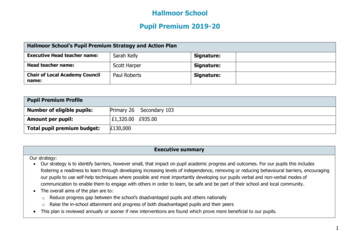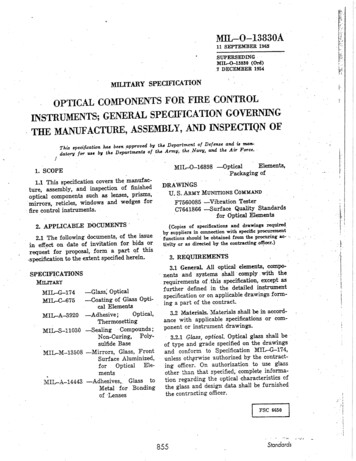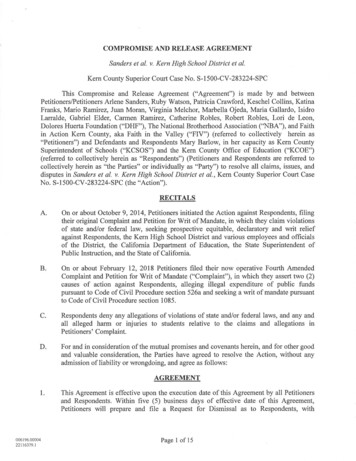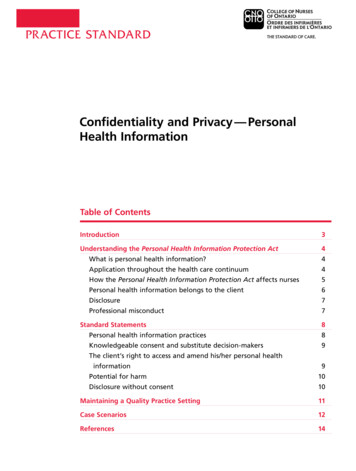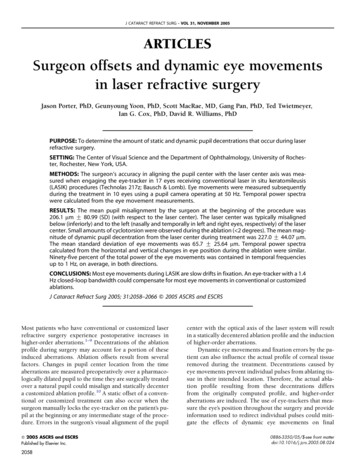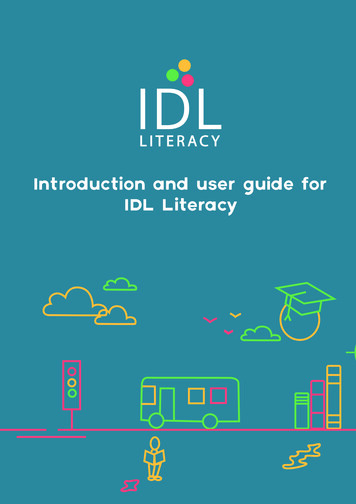
Transcription
Position StatementNECESSARY USE OF THE TITLE “SCHOOL PSYCHOLOGIST”The purpose of this position paper is (a) to summarize existing National Association of SchoolPsychologists (NASP) policy, state and federal mandates, and approved federal graduate educationstandards as it applies to the necessary use of the title “school psychologist” by specialist- anddoctoral-level school psychologists; and (b) to summarize the critical need for continued use of thetitle “school psychologist” among specialist- and doctoral-level school psychologists as they meetthe daily behavioral, academic, and social–emotional needs of the students they support.NASP advocates that all school psychologists practicing in schools under a credential awarded bytheir state education agencies or other entities that have credentialing authority, whether trained atthe doctoral or specialist levels 1 , use the established title “school psychologist” as their professionaldesignation. Specialist-level graduate education consists of 3 years of full-time graduate study in arecognized school psychology program, the accrual of 60 or more graduate credits, and thecompletion of a minimum of 1 academic year of supervised internship experience (NASP Standardsfor Graduate Preparation of School Psychologists; NASP, 2010a). As highly qualified professionalswith advanced graduate education at the specialist or doctoral level, school psychologists deliver acontinuum of needed research-based academic and school mental health services to children,families, schools, and community agencies. After receiving advanced graduate education throughrecognized school psychology programs, school psychologists are typically credentialed throughstate departments of education, with more than 90% of states explicitly credentialing schoolpsychologists by title (NASP, 2010b). The historical, legal (federal and state), and publicly acceptedunderstanding of what school psychologists, at the specialist and doctoral levels, do in everydaypractice is inextricably tied to the use of the title “school psychologist.”HISTORICAL USE OF THE TITLE “SCHOOL PSYCHOLOGIST” The earliest use of the term, “school psychologist” dates back to the late 19th Century(Munsterburg, 1898). The term’s use as an official practitioner’s title dates to the professionalwork of Dr. Arnold Gesell, a psychologist and pediatrician in Connecticut, who used theprofessional title “school psychologist” in his professional work during the years 1915–1919(Fagan, 1987).1“Specialist-level” graduate preparation for a school psychologist is defined as 60 graduate semester hours or theequivalent in school psychology, resulting in institutional documentation of various types. The following are examples ofspecialist-level documentation: 60 Master’s degree; Master’s degree plus Certificate of Advanced Study totaling 60hours (e.g., CAS, CAGS); or an Educational Specialist (EdS) degree or Psychology Specialist (PsyS) degree.NASP Position Statement: Necessary Use of the Title “School Psychologists”1
The title “school psychologist” gained greater recognition with the founding of a graduateeducation program in the School of Education at New York University in 1929, which includedthe BS, AM, and PhD degrees in school psychology.Although practitioners of school psychology provided school psychological services underseveral different titles, and increasingly as full-time school district employees, the concept andtitle of “school psychologist” was clearly discernible by the late 1930s.State recognition of the title “school psychologist” was augmented by the certification standardsadopted in New York and Pennsylvania during the mid-1930s (Cornell, 1941).National recognition of the title was conferred by the reorganized American PsychologicalAssociation (APA) that established the first national organization with this title, the Division ofSchool Psychologists (Division 16) in 1945.School psychologists (at the doctoral and specialist levels) have long been specifically designatedas qualified users of psychological and educational assessments. For example, the 1949 WechslerIntelligence Scale for Children (WISC) manual (Wechsler, 1949) identified school psychologistsas qualified users of the instrument at a time when very few practitioners held doctoral degrees.The Thayer Conference, convened in 1954 to clarify the role, function, and credentialing ofschool psychologists, gave further recognition to the title (Cutts, 1955; Fagan, 2003). Althoughrecommending that the title “school psychologist” be reserved for those credentialed at thedoctoral level, the Thayer recommendations were not widely adopted. More and more statescredentialed school psychologists at the specialist level in the decades following the conference.NASP was founded in 1969 to promote the work of school psychologists as they promoteeducational and psychological healthy environments for all children and students. At the time ofNASP’s founding, there were numerous titles, but that of school psychologist was increasinglyprominent (Farling & Hoedt, 1971). By the late 1970s, NASP and affiliated state associationshad brought the title “school psychologist,” at both the doctoral and specialist levels, to nationalprominence and respect.NASP developed and approved Guidelines for Training Programs in School Psychology in 1972, Principlesfor Professional Ethics in 1974, and Credentialing Standards and Practice Guidelines in 1978. NASPrevised these professional standards in 1984, 1994, and 2000. NASP’s current standards,approved in March 2010, include the Model for Comprehensive and Integrated School Psychological Services(NASP, 2010c), Principles for Professional Ethics (NASP, 2010d), Standards for the Graduate Preparationof School Psychologists (NASP, 2010a), and Standards for the Credentialing of School Psychologists (NASP,2010b).NASP developed the Nationally Certified School Psychologist (NSCP) credential in 1989 torecognize school psychologists who meet national standards for professional preparation inschool psychology (Batsche & Curtis, 2003). The creation of the NCSP represented a significantmilestone for school psychology as a field and for NASP as a professional association. As of2010, 31 states recognize the NCSP as one alternative to demonstrate eligibility for the statecredential in school psychology. As of March 2010, 11,728 school psychologists held the NCSP.FEDERAL AND STATE USE OF THE TITLE “SCHOOL PSYCHOLOGIST” The most recently reauthorized Individuals with Disabilities Education Improvement Act(IDEA, 2004) mandates the use of scientifically based instruction for all students. The advancedtraining of school psychologists at both the specialist and doctoral levels includes skills and a2NASP Position Statement: Necessary Use of the Title “School Psychologists”
specialized knowledge base consistent with the implementation and evaluation of scientificallybased practices.IDEA (2004) Code of Federal Regulations (CFR) specifically uses the title “school psychologist”in Section 300. 308(b) when describing the professional designation of individuals who areallowed to conduct evaluations as, “At least one person qualified to conduct individualdiagnostic examinations of children, such as a school psychologist, speech–language pathologist,or remedial reading teacher.”The No Child Left Behind Act (NCLB; 2001) frequently uses the title “school psychologist”throughout the Act. For example, school districts can document needs for school fundingrelated to expanded counseling services by reporting student to school psychologist ratios,defined as adequate when there is 1 school psychologist for every 1000 students (NCLB, 2001,Title V, Part D, subpart 2).NCLB specifically lists school psychologists as school-based mental health service providerswho are credentialed through a state agency, noting specifically that “school-based mental healthservice provider includes a state licensed or state certified school counselor, schoolpsychologist ” (NCLB, 2001, subpart 4, Section 4151). Additionally, school psychologists areincluded in the NCLB definition of pupil service personnel.When defining the term “school psychologist,” language in the NCLB describes the graduatetraining of such professionals as completion of 60 credit hours of graduate training, and anappropriate practicum and internship, consistent with the advanced graduate education at thespecialist level recommended by NASP.The National Council for Accreditation of Teacher Education (NCATE), authorized by the U.S.Department of Education to accredit schools, colleges, and departments of education who meetrigorous national standards, has adopted the NASP Standards for Training and Field PlacementPrograms in School Psychology (NASP, 2000) as its national graduate education accreditationstandards. As such, NCATE specifically endorses the graduate education of school psychologistsat the specialist level (e.g., 60 graduate semester hours, academic year internship).The U.S. Department of Labor (2009), in its most recent publication on occupational outlook,describes school psychologists by title as “collaborating with teachers, parents, and schoolpersonnel to create safe, healthy, and supportive learning environments for all students.”Additionally, the specialist degree, consistent with NASP’s (2010a) description as 3 full years ofgraduate study, a minimum of 60 graduate credits in psychology and education, and 1 year fulltime internship, is described as what is required in most states for one to work as a schoolpsychologist. Additionally, the job outlook for psychologists in the next several years is predictedto be among the best for school psychologists trained at either the doctoral or specialist levels.The Social Security Administration specifically designates school psychologists by title as“acceptable medical sources” whose opinions can be considered when making disability claims(Federal Register, 2006, 20 CFR 404.1502).The most current data available indicate that there are approximately 250 graduate educationprograms which offer degrees in school psychology across the United States (Miller, 2008).These programs specifically prepare school psychologists and can be identified as distinct fromgraduate education programs in other specialties of professional psychology, such as clinical orcounseling psychology practice.3NASP Position Statement: Necessary Use of the Title “School Psychologists”
PUBLIC USE OF THE TITLE “SCHOOL PSYCHOLOGIST” Further evidence for the strong job outlook and critical functions played by school psychologistscan be found in widely disseminated national news reports about top future careers. Forexample, in the most recent U.S. News and World Report summary of occupational outlooks,school psychologists are described as key professionals to helping students stay in school andachieve long-term success (U.S. News and World Report, 2009). While the publication predicts apromising outlook for all applied psychology disciplines, the growth area is particularlyanticipated in schools, where most school psychologists are employed.Eleven professional groups, including the National Educational Association (NEA) and theNational Alliance for Pupil Service Organization (NAPSO), have adopted formal positionsrecognizing the significant work that school psychologists do in meeting the learning and mentalhealth needs of all children and students, and continue to advocate for advanced graduateeducation at the specialist level (NASP, 2010a).ROLE OF THE SCHOOL PSYCHOLOGISTNASP supports the critical role that school psychologists have in meeting the learning and mentalhealth needs of all children and students. School psychologists need to represent themselves underthe title “school psychologist” in order to accurately represent their credentials to the public and tomeet their varied responsibilities, in the following ways: Supporting schools and related agencies to comply with federal, state, and local mandates inserving all children and students in inclusive environments to the maximum degree possible Facilitating the delivery of scientifically based practices to meet the myriad of learning, behavior,and mental health needs experienced by an increasingly diverse population of students andfamilies Working in a collegial fashion with other mental health service personnel (school social workers,school counselors, and other school psychologists) to assure that all students receive anappropriate education, regardless of race, culture, language and background, sexual orientation,socioeconomic status, or educational needs (NASP, 2009b) Serving as leaders in providing consultation, assessment, and intervention along a multitieredcontinuum, ranging from application of such supports on a prevention-oriented, populationlevel basis to delivery of more intensive supports on a small group or individual basis (BrownChidsey & Steege, 2005) Drawing from a knowledge base in both psychology and education, school psychologists are in aunique position to promote educationally and psychologically healthy environments for allchildren and students (NASP, 2010c). It is through the unique title and role of schoolpsychologists in schools that an optimal learning environment can be realized for all childrenand students.SUMMARYNASP supports the significant work that school psychologists do to meet the many learning andmental health needs of students in U.S. schools. School psychologists, with their highly specializedadvanced graduate training, are better able to serve students, schools, and families because they usethe title “school psychologist” as they work to ensure an appropriate educational experience for all4NASP Position Statement: Necessary Use of the Title “School Psychologists”
students. Over the last 100 years, a clear historical, legal, and larger public precedent has beenestablished for the use of the title “school psychologist,” resulting in clearly documented publicgood. The use of the title “school psychologist” currently supports the daily work of practicingschool psychologists, whose numbers are minimally estimated at more than 35,000 (Charvat, 2008).The continued use of the title “school psychologist” will also facilitate the work of futurepractitioners, who will fill current and expected future shortages in the field. NASP continues toadvocate for the outstanding work that school psychologist do, and use of the title “schoolpsychologist” is essential in the continuation of such work. It is the position of NASP that doctoraland specialist-level school psychologists who practice in schools under credentials awarded by theirstate education agencies (or other entities that have credentialing authority) should use the title“school psychologist” as their professional designation.REFERENCESBatsche, G. M., & Curtis, M. J. (2003). The creation of the National School Psychology CertificationSystem. Communiqué, 32(4), pp. 6–8.Brown-Chidsey, R., & Steege, M. S. (2005). Response to intervention: Principles and strategies for effective use.New York: Guilford.Charvat, J. L. (2008). Estimates of the school psychology workforce. Available:http://www.nasponline.org/advocacy/SP Workforce Estimates 9.08.pdfCornell, E. L. (1941). Certification of specialized groups (school psychologists). Journal of ConsultingPsychology, 5, 62–65.Cutts, N. E. (Ed.). (1955). School psychologists at mid-century. Washington, DC: American PsychologicalAssociation.Fagan, T. K. (1987). Gesell: The first school psychologist. Part II: Practice and significance. SchoolPsychology Review, 16, 399–409.Fagan, T. K. (2003). School psychology. In T. Millon, I. B. Weiner, & M. J. Lerner, (Eds.). Handbookof psychology, Hoboken, NJ: Wiley and SonsFarling, W. H., & Hoedt, K. C. (1971). National survey of school psychologists. Washington, DC: NationalAssociation of School Psychologists.Federal Register. (2006). Social Security Administration Ruling, 71(153), 45593–45597. Individualswith Disabilities Education Improvement Act (IDEA) (2004). Public Law 108-446.Miller, D. C. (2008). Appendix VII. School psychology training programs. In A. Thomas & J.Grimes (Eds.), Best practices in school psychology V. Bethesda, MD: Author.Munsterburg, H. (1898). Psychology and education. Educational Review, 16, 105–132.National Association of School Psychologists. (2009). Appropriate behavioral, social, and emotionalsupports to meet the needs of all students. (Position Statement). Bethesda, MD: Author.National Association of School Psychologists. (2010a). Standards for graduate preparation of schoolpsychologists. Bethesda, MD: Author.National Association of School Psychologists. (2010b). Standards for the credentialing of schoolpsychologists. Bethesda, MD: Author.5NASP Position Statement: Necessary Use of the Title “School Psychologists”
National Association of School Psychologists. (2010c). Model for comprehensive and integrated schoolpsychological services. Bethesda, MD: Author.National Association of School Psychologists (2010d). Principles for professional ethics. Bethesda, MD:Author.No Child Left Behind Act. (2001). (NCLB). Public Law 107-110.U.S. News and World Report. (2009). Best Careers of 2010. cles/2009/12/28/school-psychologist-2.htmlU.S. Department of Labor. (2009). Occupational Outlook Handbook (2010–11 ed.). chsler, D. (1949). Manual for the Wechsler Intelligence Scale for Children. New York: The PsychologicalCorporation.Approved by the Delegate Assembly on March 6, 2010Please cite this document as:National Association of School Psychologists. (2010). Necessary Use of the Title “School Psychologist”(Position Statement). Bethesda, MD: Author. 2010 National Association of School Psychologists, 4340 East West Highway, Suite 402, Bethesda, MD 208146NASP Position Statement: Necessary Use of the Title “School Psychologists”
NASP developed the Nationally Certified School Psychologist (NSCP) credential in 1989 to recognize school psychologists who meet national standards for professional preparation in school psychology (Batsche & Curtis, 2003). The creation of the NCSP represented a significant milestone for school psychology as a field and for NASP as a .
